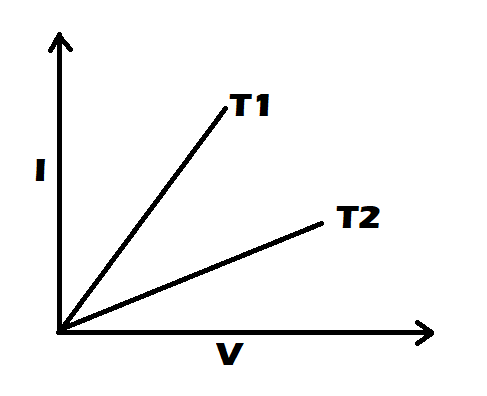
$V - I$ graph for a metallic wire at two different temperatures ${T_1}$ and ${T_2}$is shown in figure. Which of the two temperatures is higher and why?
A) ${T_1} > {T_2}$
B) ${T_1} < {T_2}$
C) ${T_1} = {T_2}$
D) ${T_1} = 2{T_2}$


Answer
572.4k+ views
Hint: The main key to these solutions is observation of the graph. After deducing the relation if we just fix any one value then we can easily deduce by obtaining a specific quantity for both at the same point by simply a line passing through both points.
Complete step by step answer:
The slope of the lines will give the inverse relation of the resistance. Resistance of the material has the property of an increase in the resistance with increase in the temperature. This happens due to an increase in the collision of the molecules with the increase of the heat energy.
So as ${T_2}$has the smaller slope so it have high resistance and subsequently ${T_2} > {T_1}$
Now if V is constant then that makes ${R_1} < {R_2}$for a specific V
Thus, ${T_1} < {T_2}$due to inverse relation.
Note: Basically as the temperature increases there is an increase in collisions inside the matter(resistor) and hence there is more hindrance to the flow of electrons and charges, which in the end increases the resistivity of the material hence increasing the resistance. For the same voltage, increase in resistance decreases the current as we can see in the graph for a vertical line, for same voltage at T2 there is low current with respect to current at same voltage at T1.
Complete step by step answer:
The slope of the lines will give the inverse relation of the resistance. Resistance of the material has the property of an increase in the resistance with increase in the temperature. This happens due to an increase in the collision of the molecules with the increase of the heat energy.
So as ${T_2}$has the smaller slope so it have high resistance and subsequently ${T_2} > {T_1}$
Now if V is constant then that makes ${R_1} < {R_2}$for a specific V
Thus, ${T_1} < {T_2}$due to inverse relation.
Note: Basically as the temperature increases there is an increase in collisions inside the matter(resistor) and hence there is more hindrance to the flow of electrons and charges, which in the end increases the resistivity of the material hence increasing the resistance. For the same voltage, increase in resistance decreases the current as we can see in the graph for a vertical line, for same voltage at T2 there is low current with respect to current at same voltage at T1.
Recently Updated Pages
A man running at a speed 5 ms is viewed in the side class 12 physics CBSE

The number of solutions in x in 02pi for which sqrt class 12 maths CBSE

State and explain Hardy Weinbergs Principle class 12 biology CBSE

Write any two methods of preparation of phenol Give class 12 chemistry CBSE

Which of the following statements is wrong a Amnion class 12 biology CBSE

Differentiate between action potential and resting class 12 biology CBSE

Trending doubts
What are the major means of transport Explain each class 12 social science CBSE

Which are the Top 10 Largest Countries of the World?

Draw a labelled sketch of the human eye class 12 physics CBSE

Explain sex determination in humans with line diag class 12 biology CBSE

Explain sex determination in humans with the help of class 12 biology CBSE

Differentiate between homogeneous and heterogeneous class 12 chemistry CBSE




